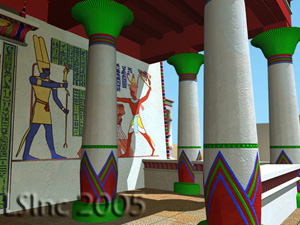Gebel Barkal, Nubia• The Temple B700 Virtual World • |
Gebel Barkal, Nubia• The Temple B700 Virtual World • |
page updated December 24, 2007
| Developed in the Fall of 1995, the original virtual world of Temple B700 features many of the elements that make LEARNING SITES products unique: |
Screen shot from one of the first virtual ancient worlds ever created for interactive research, having linked databases, and high-resolution textures. |
|
|
|
Originally, this virtual world was available from LEARNING
SITES, for museums, exhibits, research, or coursework. Gebel Barkal: Temple
B700 came in two versions (the world could have been viewed with or without HMDs):
2) For Silicon Graphics Incorporated Onyx workstations with a Reality Engine 2, IRIX operating system version 5.3 or higher, and 150Mb of available hard drive space, and Sense8 Corporation's, WorldToolKit (version 2.1). |
|
View over the existing remains of B700 (photo courtesy of Timothy Kendall). |
Temple B700 at Gebel Barkal was constructed about 650-640 BCE by two Kushite kings about whom little is known: Atlanersa, who died when the temple was only partly finished, and Senkamanisken, who completed the work. These kings were the two immediate successors of the last Kushite pharaohs of Egypt, and thus the temple is clearly Egyptian in its architectural and decorative styles. B700 is quite small, only about 20 X 33m, comprising a porch, pylon, two main inner rooms, and a small space added to the rear possibly in the first century BCE. |
| The temple was first excavated between February and April 1916 by George Reisner and his Boston team and again between March and April 1987 by the new Boston team led by Timothy Kendall. In 1989 Kendall and his staff resurveyed the monument. | |
| The first 3D computer model of the temple was created by Bill Riseman in 1990. At the right is a rendering of the pylon of B700 from that model (click on the image to enlarge). |
|
| Although little remains today of the wall carvings and inscriptions, the surviving evidence, excavation notes, and 19th-century drawings of the temple's pylon have enabled us to reconstruct the images and much of the building's narrative program. | |

B700 pylon porch (digitally reconstructed). (click the image to enlarge) |
LEARNING SITES worked closely with Egyptologists to ensure the integrity of the resulting visualization of the Temple B700. Under the leadership of Timothy Kendall, analyses of the hieroglyphics have provided clues to the function of this small religious structure. However, whether the building was originally planned as temple to deceased kings or whether its function was established only following the premature death of Atlanersa is uncertain. |
|
| (compiled in 1997 for Learning Sites by Timothy Kendall, then of the Museum of Fine Arts, Boston)
1820, December. George Waddington and Barnard Hanbury. 1821, February. Frédéric Cailliaud. 1821, February. George B. English. 1821, October. M. Linant de Bellefonds and Alessandro Ricci. 1822, April. Frédéric Cailliaud. 1828. Lord Prudhoe and Major Orlando Felix. 1828. James Burton. 1829. Edouard Rüppell. 1833. George A. Hoskins. 1835, September. John Lowell and Charles Gleyre. 1844, May. Karl Richard Lepsius. 1848 and 1849. John Gardiner Wilkinson. 1897. E. A. Wallis Budge. 1906, December. James H. Breasted. 1916, January to April. George A. Reisner. 1986-present. Timothy Kendall. |
|
|
|
Reference Information
page added February 27, 1997
page updated December 24, 2007
you are here: Learning Sites home page ==> Learning Sites Index page ==> Gebel Barkal Index page ==> Temple B700
this page's URL is: http://www.learningsites.com/GebelBarkal-2/GB-B700v2.htm© 1997-2007 Learning Sites, Inc.